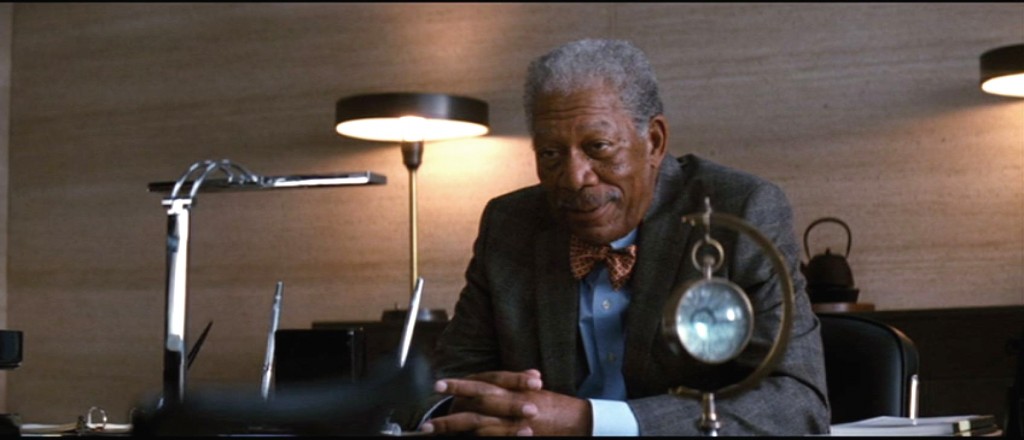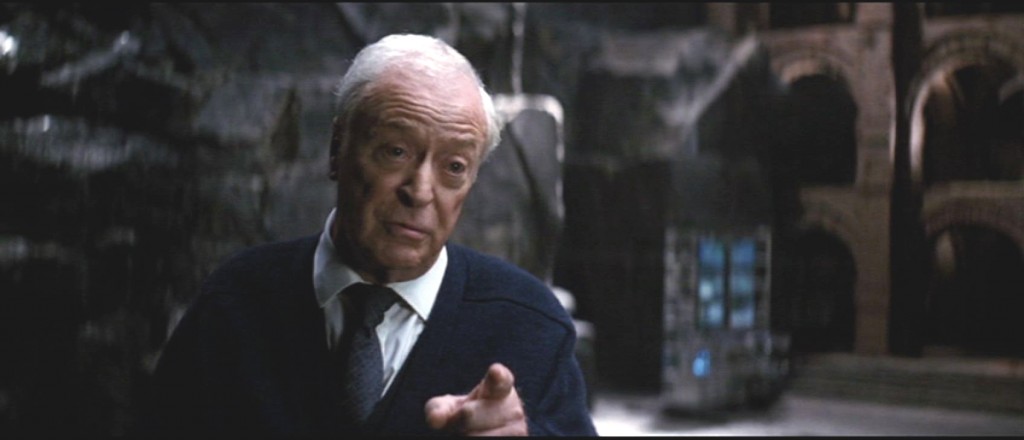Batman: The Dark Knight Rises part 5
The next step on Bruce Wayne’s road to recovery is stopping in to see Lucius Fox, the inventor to whom Bruce entrusted the running of his company back in Begins. Lucius finally brings Bruce’s monetary woes into focus — he spent his entire research-and-development budget on this mysterious “save-the-world” project, then cancelled it, leaving Wayne Enterprises ripe for takeover by industrial predator Daggett. (If Harvey Dent was Daytime Batman, John Daggett is Overground Bane, taking over Bruce’s legitimate business while Bane prepares to go after his darker identity.) Note that the screenplay still doesn’t tell us what the project is, exactly. Because what the project is is the maguffin of the piece, and if we know what it is too soon, it tips the narrative’s hand in undesired ways. Suffice to say that the comely Miranda Tate was instrumental in developing said project, and that Lucius strongly supports Bruce settling down with her. And, when Lucius is played by no less a personage than Morgan Freeman, the viewer takes it on faith that if Lucius wants you to settle down with a particular woman, you should probably do that.
And, even though Bruce insists that Batman is retired, Lucius lures him into his personal Batcave to show off his new gadgets. It seems odd to force a scene of gadget-display onto a superhero who doesn’t have a stated mission, but it’s all part of the seduction: Selina draws out Bruce’s interest as a criminal, Miranda draws it out as a force of change, Alfred draws it out as a trusted friend, Gordon draws it out as wounded ally, Blake draws it out as a secret admirer, now Lucius draws it out with the promise of toys. But the scene also performs a narrative service — the location, which was always just “somewhere in the basement” before, in Rises becomes a linch-pin of the plot. If we don’t feature it now, by the time it becomes important it will seem like its inclusion comes out of the blue.
(The toy on dispay is The Bat, a helicopter-type thingy, and mention is made of the autopilot program. This is all exposition, but it’s couched in thematic terms: Lucius has consolidated all of Wayne Enterprises weaponry under one roof, or in one cave, in order to keep it from falling into the wrong hands. This will prove to be foreshadowing.)
Bruce puts on a knee brace that allows him to kick holes in brick walls and, for the second time, listens to Alfred deliver some information on Bane. Bane, we learn, was born in a prison (shades of Dickens) and rose from a pit (shades of Revelations) and was a protege of Ra’s Al Ghul (shades of Bruce) but was excommunicated from the League of Shadows because he was too extreme. Almost everything Alfred says here turns out to be disastrously wrong. Dramatically, what’s happening in the scene is that, as Bruce is listening, we see that the collective coaxing of everyone Bruce knows has lured him into Bat-mode again, even as he protests every step of the way that he’s not, he’s really not. It’s also worth noting that Alfred, here in his role as teacher-helpmate-father-figure, has no analogue in the rest of Bruce’s world. That is, none of the costumed freaks Bruce deals with have their Alfreds, and most all the other characters are versions or reflections of Bruce himself. Alfred stands alone in the Batman universe, I think, to show that Bruce’s advantage over his enemies is that he’s willing to take advice from an older, subservient man — it’s impossible to imagine, say, the Joker pausing to consider the counsel of his oldest, most trusted henchman. Alfred, in that way, is Bruce’s superpower.
What does Alfred want? Great question. In Begins, Alfred dreaded Bruce becoming Batman, but in Knight he chastised Bruce for wanting to give up. Now, in Rises, the moment Bruce steps to don the cowl again, Alfred begs him to reconsider. Bruce, he argues, can be his own Daytime Batman, affecting change legitimately, he can’t risk going up against a madman like Bane mano-a-mano. His worry, it seems, is less that Bruce might die, but that he’s moved from “recluse” to “martyr.” The servant who was begging Bruce to get back into the world is now worried that he’s going about it the wrong way, for the wrong reasons.


It was predictable that Miranda was gonna turn out to be a villain for a couple of reasons. First, before the reveal, she was a very uninteresting character. So what’s the point of having her in the movie? She has to be a bad guy.
Second, Batman already has a love interest in Cat Woman. A much more interesting love interest. So why bother having this redundant love interest? Again, she has to be a bad guy.
It still works if you think of Miranda as the Bruce Wayne love interest, and Catwoman as the Batman love interest. Finding one to be more interesting than the other helps explain why he puts the cowl on again.
For fans of the comics, we knew right away, not because she was uninteresting (I certainly never thought so) or bland, but because we have familiarity with Talia. Talia runs LexCorp of the Superman/DC universe. So we have Miranda, a business woman. Secondly, Talia is the mother of Bruce’s only biological child; she seduces him into getting her pregnant because she wants an heir to the League of Shadows empire, as it were. She has only a passing interest in her ‘beloved’ as she calls Bruce, and he is truly taken in by her in the comics, having no idea that she is using him. So the moment that they sleep together in the movie, I was positive of my inclinations that she would turn out to be Talia. While there is no ‘child’ plot, no Damian to speak of, she is still using him, the baby being the fusion reactor, which she wants access to more than anything else. Lastly she (like I mentioned in an earlier post about Blake) serves to appease the rules of trilogy by bringing everything full circle. She is the Ra’s of Rises, the connection back to Begins.
This is just a tiny screenwriting gracenote, but I thought it was very clever the way they disguised the auto-pilot clue – normally it’s such a small bit of info it’d just be slipped into the conversation, but of course these days most cinema goers are savvy enough that any small bit of info gets noticed and we would have immediately thought “ah, why is that tiny bit of info being included? It’s almost certain to come up later blah blah blah”. But by making it seem like the purpose of the auto-pilot mention is just Lucius trying to get Bruce interested in doing something such as fixing it, to ease him back into being batman, because we think we know what that dialogue’s purpose was, we don’t imagine that it could have two purposes, and so we are fooled (or at least I was).
Well exactly. If exposition is imperative, root it in character. When you root it in character it fills a dramatic purpose. If those things are impossible, make it a joke.
When Batman started dragging the bomb off at the end, I thought, auto-pilot! But you’re right that when it’s introduced, it’s very well-disguised as something other than a gun on the mantel.
Exposition is hard.